The Magnolia tree, with its enchanting blooms and timeless elegance, stands as a botanical marvel cherished in landscapes worldwide. Renowned for its breathtaking flowers and diverse array of species, the Magnolia tree captivates with its sheer beauty and grace.
From the majestic Southern Magnolia (Magnolia grandiflora) with its creamy-white blossoms to the delicate Star Magnolia (Magnolia stellata) adorned with star-shaped petals, each variety offers a unique spectacle to behold.
Different Types of Magnolia Trees
Wilson’s magnolia (Magnolia wilsonii)
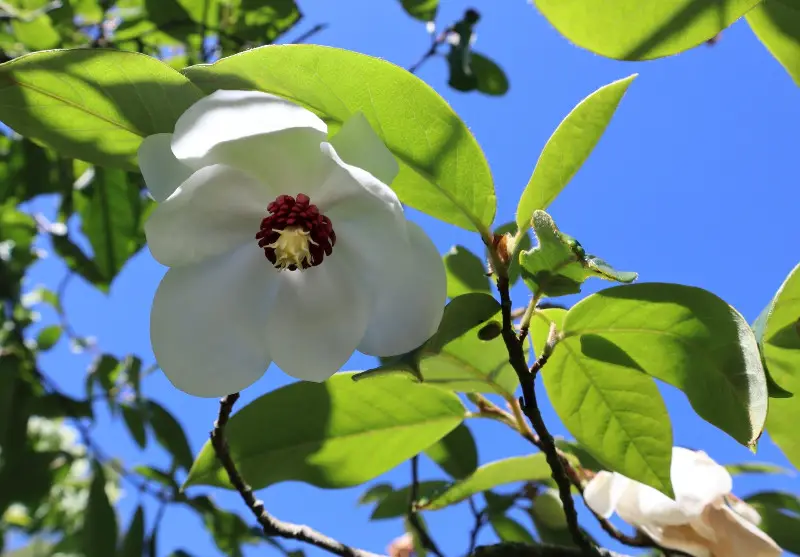
Wilson’s magnolia, scientifically termed Magnolia wilsonii, graces gardens with its drooping, cup-shaped flowers in May. Native to southern China, it thrives in warmer climates, preferring slightly acidic, consistently moist soil. The white petals elegantly encircle a dark purple stamen, adding to its beauty.
Sporting a vase-like form, it adapts well as a large shrub or small tree. To mitigate excessive summer heat, partial shade is recommended in hotter regions. Resilient and low-maintenance, Wilson’s magnolia experiences minimal issues with disease or pests.
Anise magnolia (Magnolia salicifolia)
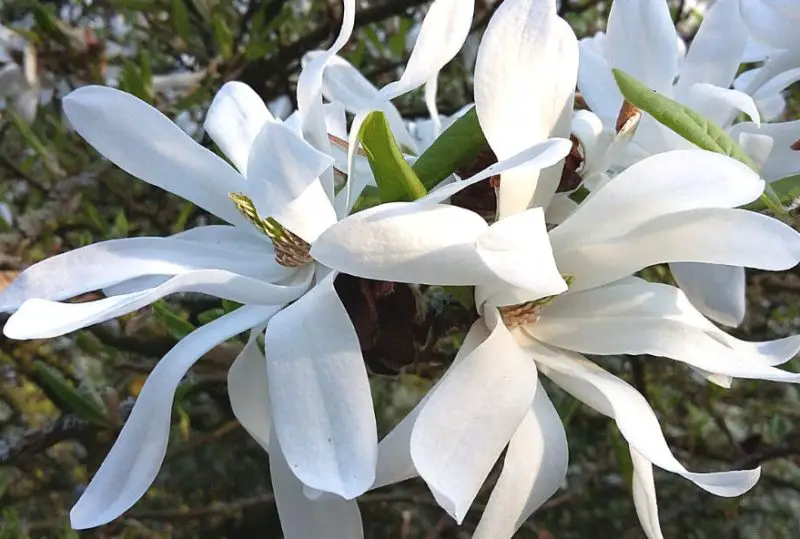
Originating in Japan, the Anise magnolia reaches heights of around fifty feet and has a pyramidal form at maturity, having evolved from a narrower upright structure in youth. Its fragrant blossoms, which have white petals with softly curled edges, charm early spring with a perfume reminiscent of lemons.
Its narrow, willow-like foliage appears first, and when the deciduous leaves are crushed, they release the same cool scent as the bark. Growing well in acidic soils with good drainage and partial shade, it is benefited by summer pruning when leaves are showing to maintain its health and vigorousness.
Lily magnolia (Magnolia liliiflora ‘Nigra’)
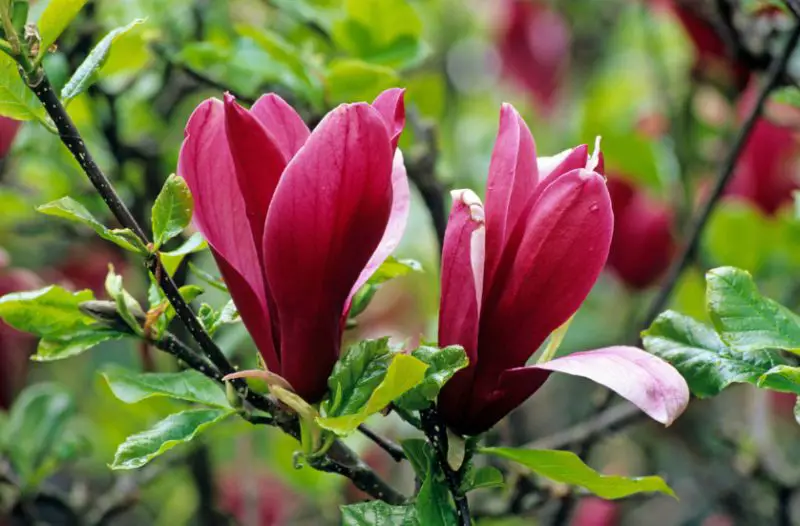
Lily magnolia (Magnolia liliiflora ‘Nigra’) thrives in Hardiness Zones 5 to 8, reaching a mature height and spread of 8 to 12 feet. This cultivar delights in full sun to partial shade, preferring slightly acidic to neutral soil with moisture. ‘Nigra’ stands out among its counterparts with its compact form and late-blooming, sizable flowers.
Sporting six to nine five-inch-long tepals, these blooms boast an exterior of rich purple complemented by a light purple interior. Following the flowers, cone-shaped fruits emerge. The dark green obovate leaves, while deciduous, may encounter mildew issues in late summer. Despite this, care and maintenance are generally hassle-free for the lily magnolia.
Saucer magnolia (Magnolia × soulangeana)
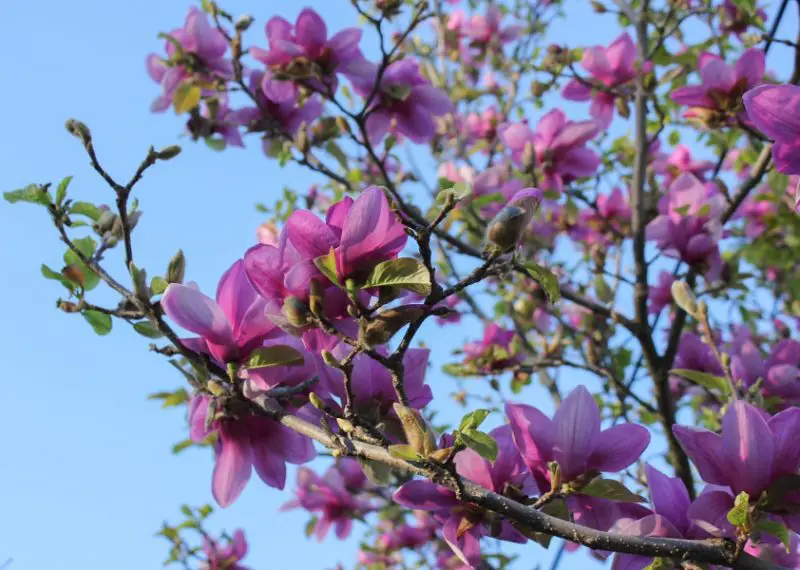
The Saucer magnolia, with its stunning blend of white and pink eight-inch flowers, stands as a favorite among deciduous magnolias. Thriving in hardiness zones 4-9, this wide-spreading small tree, often multi-stemmed, reaches a mature height and spread of 20-25 feet.
Its simple leaves, twice as long as they are wide, add to its beauty, tapering to sharply pointed tips. Preferring acidic soils and moist conditions, it flourishes in full sun to part shade, offering multiple blooms from March onward, though subsequent flowers may exhibit less intense coloration. Winter wind protection ensures its continued vibrancy.
Loebner magnolia (Magnolia × loebneri ‘Merrill’)
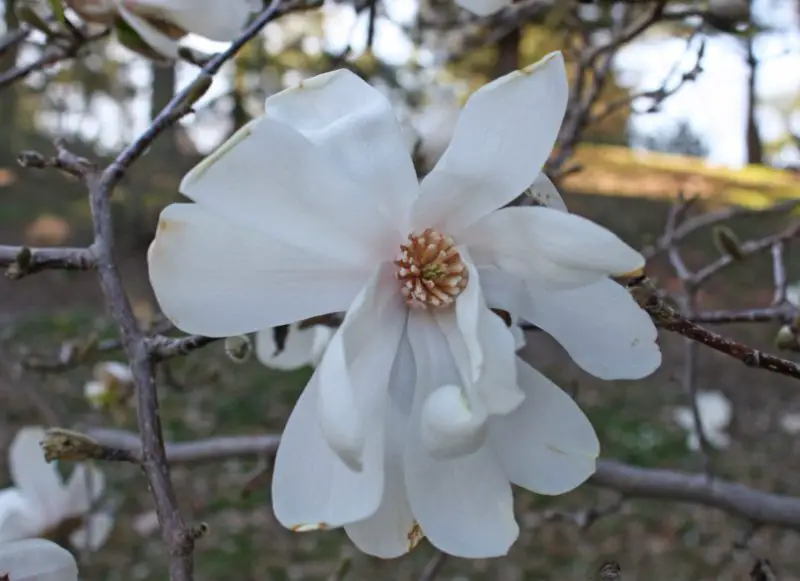
The Loebner magnolia, derived from the star magnolia and Magnolia kobus, graces gardens with its star-shaped white flowers in March and April. With ten to 15 petals and a span of five inches, these blooms exude elegance. Thriving in hardiness zones 5-9, it boasts a mature height and spread ranging from 20-60 feet and 20-45 feet respectively, often appearing multi-stemmed yet capable of growing as a small tree with a single trunk.
Its deciduous, oval-shaped leaves complement its beauty. Planting in unpolluted areas and opting for the ‘Merrill’ variety enhances winter hardiness, safeguarding against frost damage to early blooms.
Oyama magnolia (Magnolia sieboldii)

The Oyama magnolia, characterized by its unique two-toned flowers, features white petals contrasted with a dark red stamen. Blooming later in the season, these cup-shaped flowers tilt horizontally or slightly downward, adding to their distinctiveness. With a vase-shaped form, this deciduous plant often manifests as a shrub, rarely exceeding 15 feet in height.
It has rough-textured leaves, but caution is warranted in extreme heat to prevent leaf scorch. Additionally, it thrives in slightly acidic, moist soils, showcasing its preference for optimal growing conditions.
Kobus magnolia (Magnolia kobus)
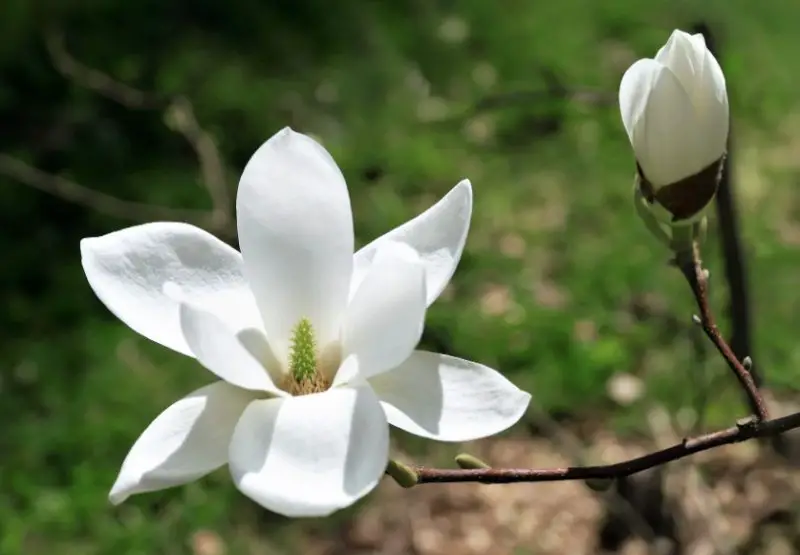
When fully grown, the medium-sized Kobus magnolia tree, which is native to Japan, has a wide-spreading shape. It grows well in wooded settings and is hardy in zones 5-8. The popular name of this plant is derived from the Japanese phrase meaning “fist”, which describes the shape of the flower buds before they open.
The goblet-shaped flowers, which are about four inches wide, are grouped six to nine times and have white petals with faint pink or purple bases. Though it might take up to 30 years for the first blossoms to appear, this magnolia is among the first to bloom in the spring with fragrant, deciduous, dark green foliage.
Zen magnolia (Magnolia zenii)
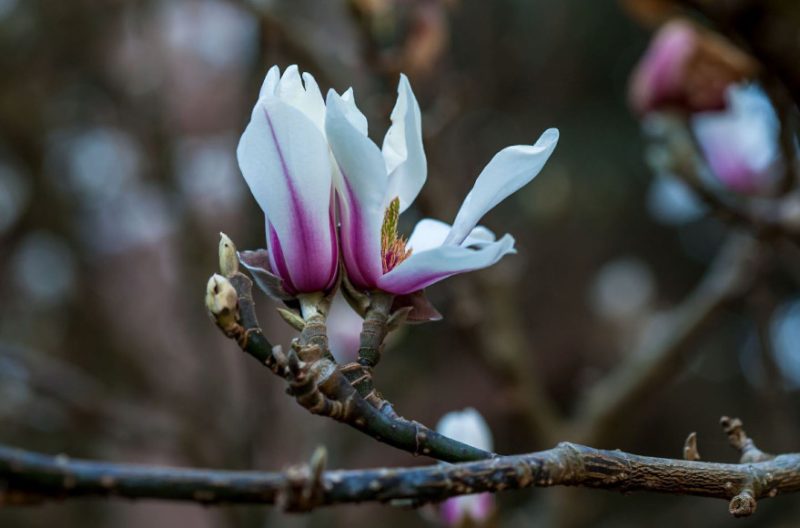
The Zen magnolia, native to China, graces landscapes with its ornate presence despite dwindling numbers in its natural habitat. Bursting into bloom as early as late January, but typically in March, its white tepals adorned with prominent fuchsia markings create a striking spectacle.
With leaves boasting a simple elliptical shape and undulating texture, this deciduous tree thrives in acidic to neutral soils with ample moisture, adapting even to sand and clay. Preferring full sun exposure, it demands at least six hours of sunlight daily, with wind protection crucial in colder regions due to its exceptionally early flowering.
Sprenger’s magnolia (Magnolia sprengeri ‘Diva’)
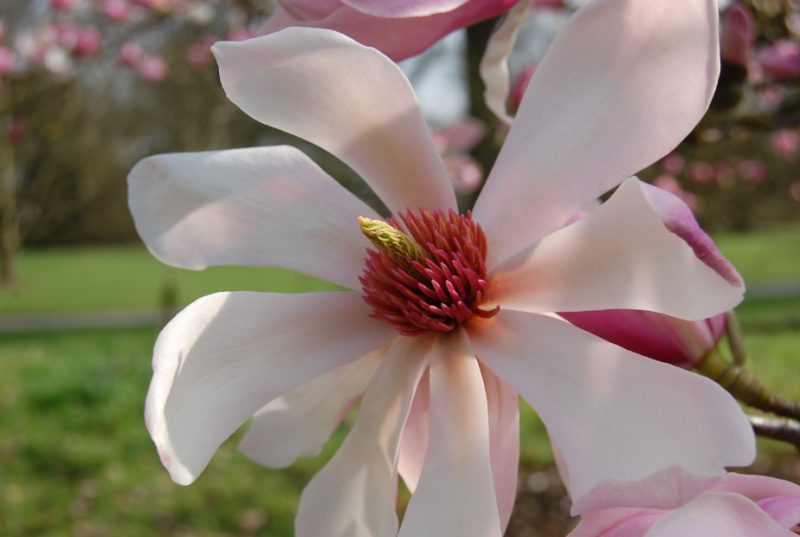
Sprenger’s magnolia, known as Magnolia sprengeri ‘Diva’, presents as a medium to large tree with a rounded form, reaching heights of 30-50 feet. With magnificent soft pink petals gracefully curving inward, they encircle a textured pink stamen, forming captivating cup-shaped flowers.
Blooming in abundance early in its life and slightly later in spring, it mitigates risks from late-season frosts. Thriving in acidic to slightly alkaline soils, it attracts pollinators like birds and butterflies. Pruning in mid-summer, while watching for issues like root rot, fungus, and magnolia scale, ensures its continued health and beauty.
Ann magnolia (Magnolia ‘Ann’)
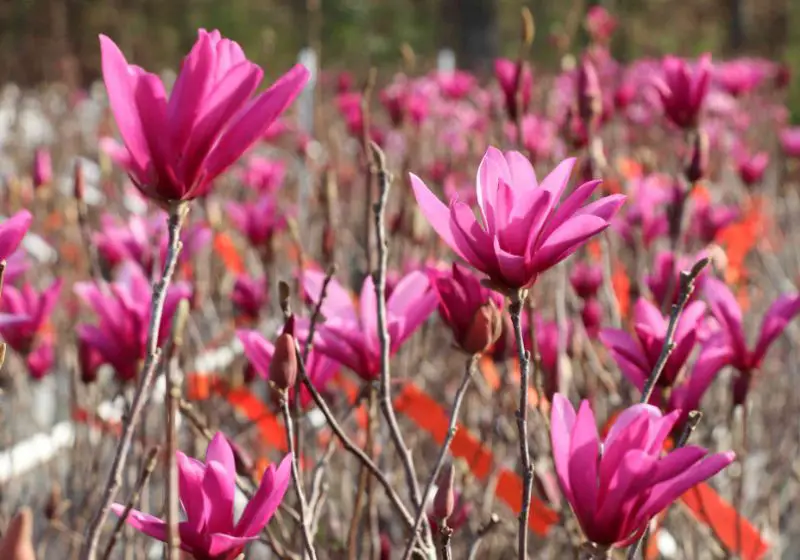
The Ann magnolia, a cross between Magnolia stellata ‘Rosea’ and Magnolia liliflora ‘Nigra,’ grows to be a tiny tree with an open growth habit. Its rich purple blossoms, with seven or nine petals each, enthrall passersby when they bloom in April and May.
Although the delicate root system makes transplanting difficult, the only pruning that is required is the elimination of dead branches. Mulching over the root zone of plants that thrive in medium moisture soils with a pH range of slightly acidic to neutral helps to maintain ideal soil moisture levels.
Betty magnolia (Magnolia ‘Betty’)
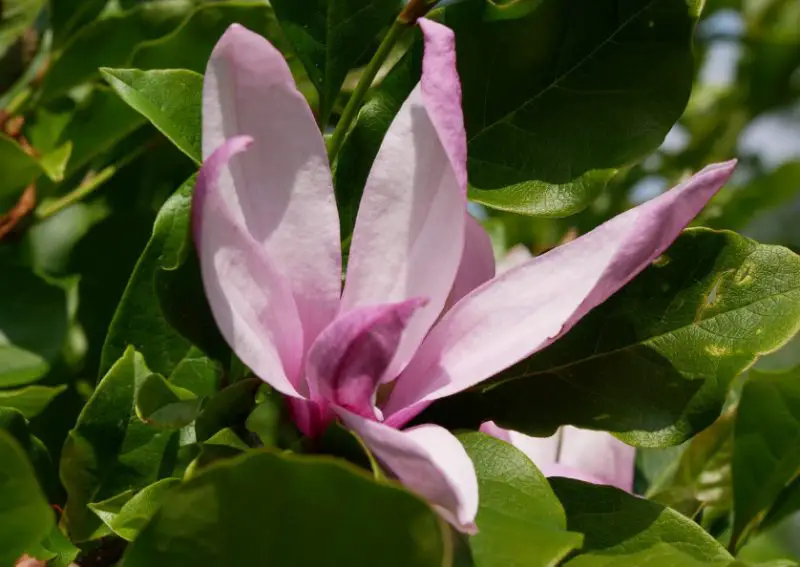
The Betty magnolia, akin to the Ann magnolia, arises from a cross between Magnolia liliflora ‘Nigra’ and Magnolia stellata ‘Rosea’, albeit with subtle distinctions. Growing larger at 10-15 feet, it features two-toned flowers, with purple to nearly red exteriors and white or washed-out pink interiors. Its leaves transition from bronze in fall and mid-spring to a traditional green hue in summer.
Despite its slow growth, Betty magnolia poses minimal maintenance and pest concerns, making it an appealing addition to gardens within hardiness zones 4-8, thriving in medium moisture soils with a slightly acidic to neutral pH under full sun to part shade conditions.
Susan magnolia (Magnolia ‘Susan’)
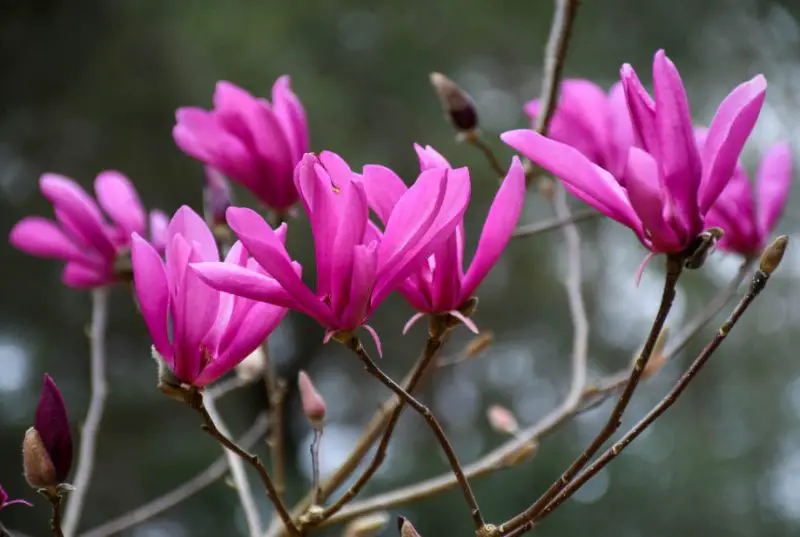
Susan magnolia, arising from the cross of Magnolia liliflora ‘Nigra’ and Magnolia stellata ‘Rosea’, exhibits enhanced hardiness compared to other Little Girl magnolias. With its deep purple flowers tinged with a reddish hue, Susan magnolia has consistency in coloration across each petal. Notably, it produces the largest flowers among its counterparts. Its buds emerge slender and elongated, unfurling into slightly twisted tepals.
Thriving in acidic to neutral soils under full sun to part shade, Susan magnolia is generally trouble-free, save for mildew susceptibility. Within hardiness zones 3-8, it flourishes in moist conditions, contributing to the allure of any landscape.
Southern magnolia (Magnolia grandiflora)

The Southern magnolia, or Magnolia grandiflora, stands as a majestic evergreen, reaching heights of 80 feet at maturity. Adorned with creamy-white flowers boasting six large petals, it graces the South with its beauty from spring through summer. Following the blooms, cone-shaped seed clusters emerge, each seed connected by delicate threads.
Its large, glossy green leaves, about ten inches long, add to its beauty. While thriving in moderately moist soil and partial shade, it requires protection from harsh winter conditions, making it a cherished sight in zones 7-9.
Cucumber magnolia (Magnolia acuminata)

The Cucumber magnolia, classified as Magnolia acuminata, is a deciduous species characterized by its pyramidal shape, which rounds out as it matures to a towering height of 70 feet. Thriving in zones 3-8, it favors soils with medium to high moisture levels, commonly found along rivers and in woodlands across the Eastern United States.
While resilient to moist conditions, extreme wetness or dryness poses a threat to its longevity. With greenish-yellow flowers and dark green deciduous leaves, it’s adaptable and often features a single straight trunk, making it suitable for colder climates.
Bigleaf magnolia (Magnolia macrophylla)

With up to 30 inches of length, the bigleaf magnolia, or Magnolia macrophylla as it is formally called, has the largest simple leaves in North America. Its gorgeous flowers, which are mostly white with purple at the petal base, are matched by red, egg-shaped fruits that mature in late summer.
Even with its grandeur, it can be difficult to find fruit and flowers atop its towering 30–40-foot frame. It is a great addition to unpolluted landscapes, but it needs protection from strong wind gusts that can damage the large leaves. It thrives in moist, acidic soils in zones 5-8.
Star magnolia (Magnolia stellata)
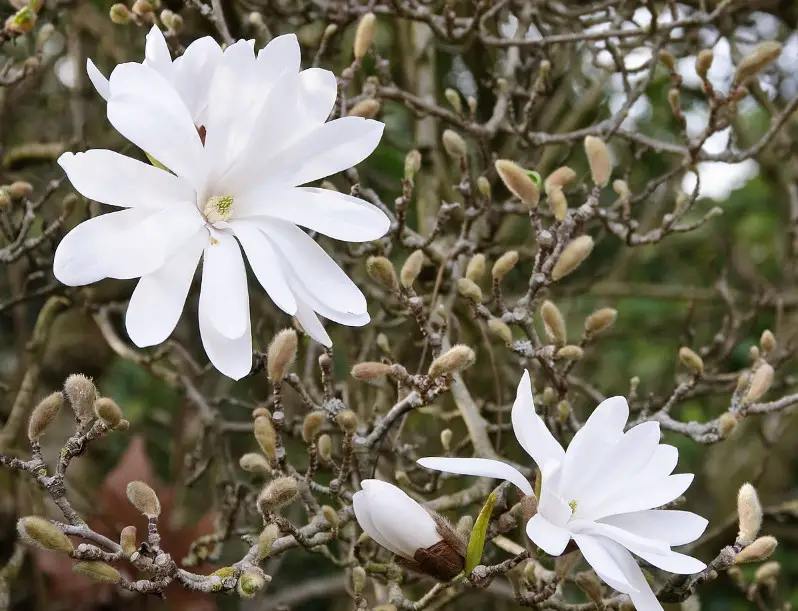
The star magnolia, native to Japan, is a small tree famous for blooming in March. Adorned with star-shaped white flowers 4 inches in diameter, small, tapering leaves appear. Thriving in moist, acidic soils in zones 4–8, it hates harshness and soil contamination.
Care should be taken to avoid direct exposure to the southern sun, as the plant may bloom prematurely, at risk of damage from late freezes. Choosing the right planting location will ensure this plant’s glorious beauty thrives throughout the seasons.
Yulan magnolia (Magnolia denudata)
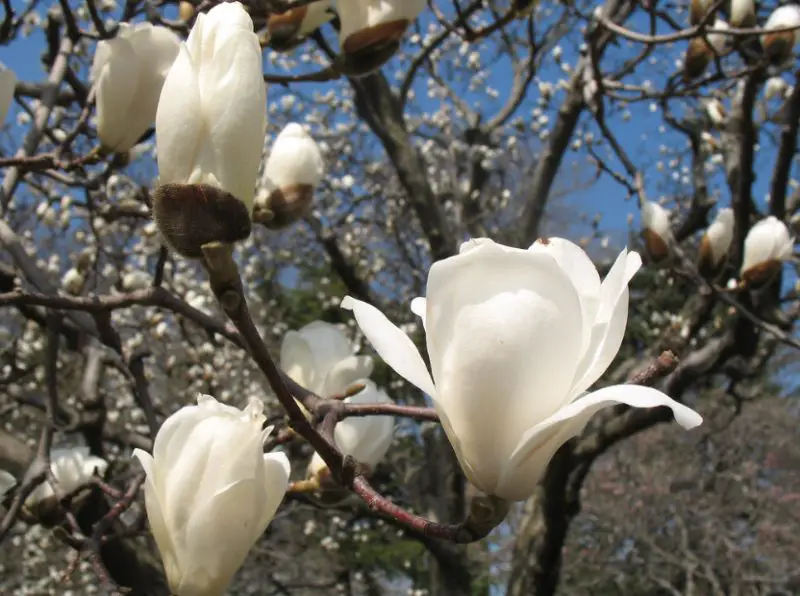
The Yulan magnolia, hailing from China, presents a mid-sized deciduous marvel, often adopting a broad pyramidal form or shrub-like stature. Adorning its branches in early spring, exquisite white flowers emerge, featuring smooth, curled petals arranged in sets of ten to 12, forming elegant bowl-like shapes.
While thriving in zones 6–9 and preferring moist, acidic soils, it’s less suited for colder climates, as late winter frosts may harm its delicate blooms. Patience is requisite, as this tree typically takes around five years to grace the garden with its inaugural blossoms.
Cylindrical magnolia (Magnolia cylindrica)
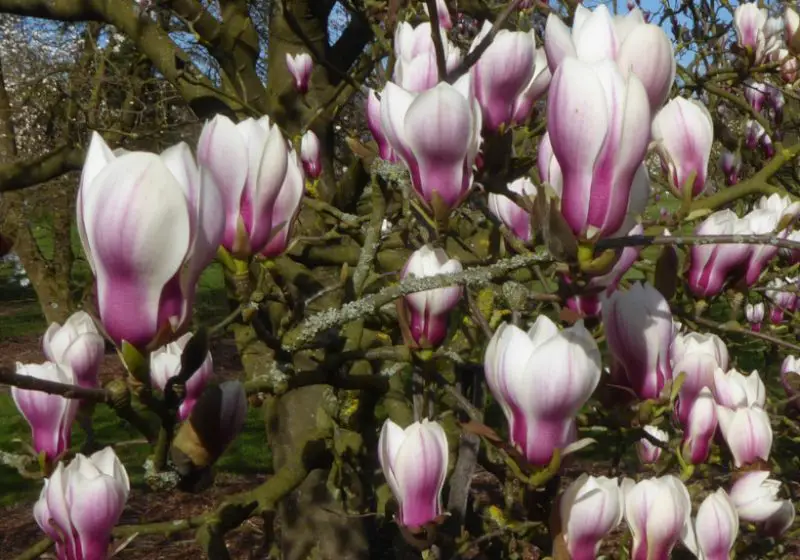
Originating from China, the Cylindrical magnolia showcases a slender vase-like silhouette, reaching heights of 30 feet. Its blooms, appearing in April and May, boast nine large petals forming distinctive three-pointed shapes. Initially white, these flowers transition to pink hues as the season progresses. Maintaining moist soil with a layer of mulch is key, while avoiding southern exposure guards against premature blooms vulnerable to late frosts.
Additionally, in warmer regions, protection from intense sunlight prevents scorching of its deciduous foliage. The unique cylindrical fruits, around 5 inches long, emerge after flowering, initially tinted bronze before maturing to dark green.
Sweet bay magnolia (Magnolia virginiana)
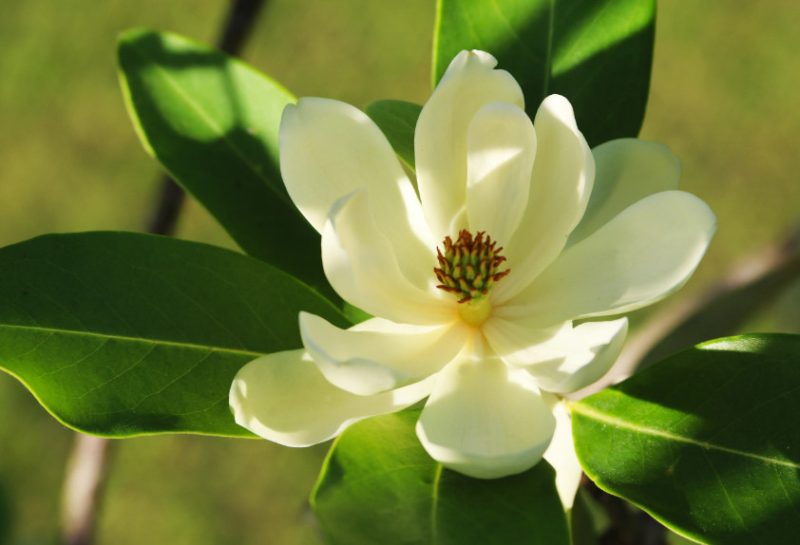
A medium-sized native tree common throughout the Eastern Seaboard, the Sweet Bay magnolia grows well in a variety of hardiness zones. It can adapt, but in severe northern winters, it can suffer. It is perfect for rain gardens since, in contrast to many magnolias, it thrives in really damp soils.
Its fragrant flowers, which are less flashy and bloom in the middle of spring, have nine or more petals that are each approximately two inches across. This species’ evergreen, glossy leaves, which resemble rhododendron foliage. It is a flexible and attractive addition to a variety of settings, preferring acidic soils and medium to high moisture levels.
Umbrella magnolia (Magnolia tripetala)
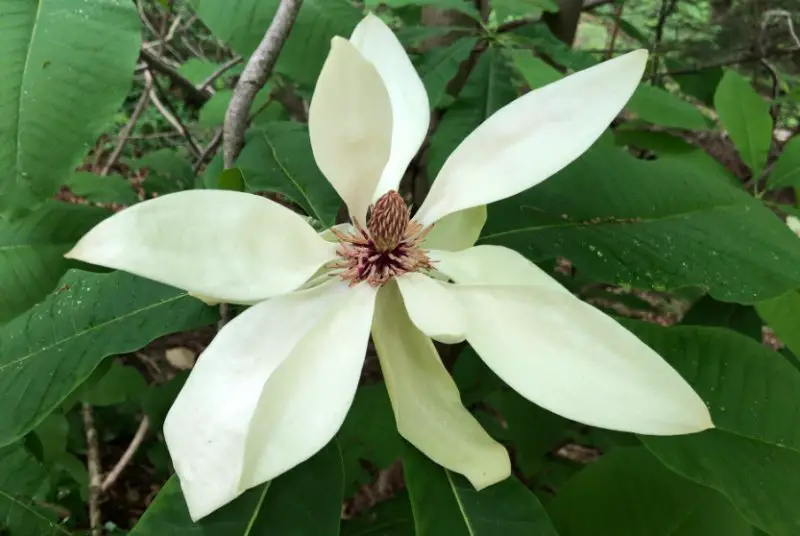
The Umbrella magnolia, classified as Magnolia tripetala, typically grows between 15 to 30 feet in height, occasionally reaching heights exceeding 40 feet. Its moniker stems from the striking resemblance of its leaves to those of the Bigleaf magnolia, often appearing as miniature umbrellas clustered at branch ends. Deciduous and sizeable, these leaves can stretch nearly two feet in length.
Blooming after leaf emergence, its cream-colored flowers, though large, may emit an unpleasant odor, featuring up to 12 tepals arranged circularly with a diameter exceeding nine inches. Thriving in part shade with consistently moist soil, this distinctive magnolia adds uniqueness to any landscape.






